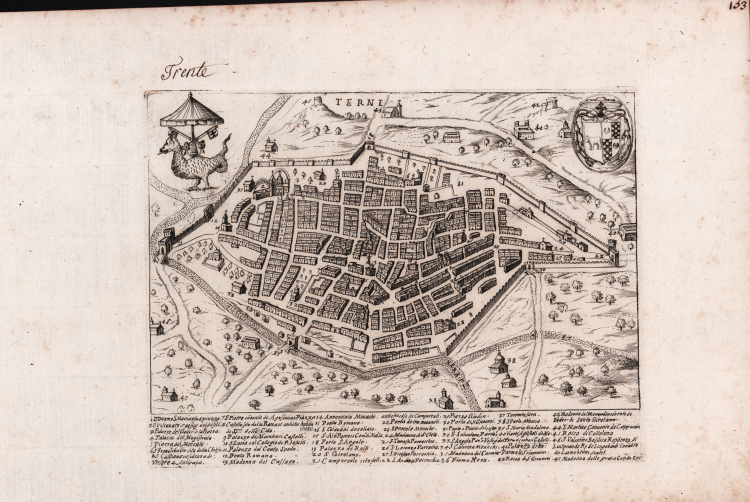




| Reference: | S39417 |
| Author | Giacomo LAURO |
| Year: | 1637 ca. |
| Zone: | Terni |
| Measures: | 235 x 185 mm |



| Reference: | S39417 |
| Author | Giacomo LAURO |
| Year: | 1637 ca. |
| Zone: | Terni |
| Measures: | 235 x 185 mm |
Map of the city taken from Heroico Splendore delle Città del Mondo, a very rare publication printed for the first time in Rome in 1639, and later, expanded with the addition of ten new works, in 1642.
Giacomo Lauro, was an engraver, printer and connoisseur of antiquities active mainly in Rome between 1583 and 1645. We do not know the date and place of birth, but the fact that he signed his works as "Jacobus Laurus Romanus" suggests that he was a native of Rome. Nothing is known about his education. The first documentary evidence of his presence in Rome, in which he is defined as a "Roman copper engraver", dates back to 1583; while his first known print is a Tiberius with a dagger (or The Gladiator), published by Claudio Duchetti in 1585. Although he dealt with historical, mythological, devotional themes, Lauro is mainly known for the production of plans and views of cities, starting with the bird's eye view of Rocca Contrada (Arcevia), made in 1594 for Angelo Rocca on a drawing by Ercole Ramazzani. In the years 1630-45, Lauro dedicated himself to the publication of a series of maps and descriptions of Italian and foreign cities in the form of small pamphlets, some of which were collected in 1639 under the title of Heroico Splendore delle Città del Mondo.
Lauro's plans, therefore, were the result of a long research work, based on primary sources, and published for the first time in books or pamphlets with text related to the history of the city. Thomas Ashby writes: "In the years 1630-1645 the Lauro published a considerable number of descriptions of cities in many pamphlets with text, all in small oblong folio. The plants are not all original [...] Many times have been used as sources, of course, the beautiful plates of the Atlas of Lafrèry. But other maps were also contributed - much was taken either from the work of Braun and Hogenberg, Civitales Orbis Terrarum, or even in this case from common sources. There is no lack of contact with Matteo Florimi of Siena, who in no case did his own work, but always copied the work of others. Some of these maps were collected under the following title, engraved in 1639; HEROICO SPLENDORE DELLE CITTA DEL MONDO LIBRO PRIMO DI IACOMO LAURO ROMANO Dove si uedono le piante di molte Citta Ill.ri e di molte non più state alla stampa con le loro origini et atti segnalati, et quanto si estende il dominio di esse sino alli presenti tempi in Roma l’Anno di nostra salute 1639” (see Thomas Ashby, L'Heroico splendore delle città del mondo, in "La Bibliofilia", XXXI (1929), pp. 105-122).
The work was reprinted in 1642 with imprint in Roma l’Anno di nostra salute 1642 /Con priuilegio del somo Pontefice, et d'altri Potent.ti Con licenza de Superiori. Although the title page speaks of "Book one" a second volume of the collection was not published.
Copper engraving, printed on contemporary laid paper, with margins, very light oxidation, otherwise in excellent condition. Very rare.
Bibliografia
Thomas Ashby, Un incisore antiquario del Seicento, I, Note intorno alla vita ed opere di Giacomo Lauro, in “La Bibliofilia”, XXVIII (1926-27), pp. 361-373; II, L'opera "Antiquae Urbis splendor", ibid., pp. 453-460; III, ibid., XXIX (1927), pp. 356-369; IV, L'Heroico splendore delle città del mondo, ibid., XXXI (1929), pp. 105-122.
|
Engraver, printer and print publisher. Active in Rome from 1583. 17 March 1598 he applied for and was granted a ten-year papal privilege for an unspecified number of unnamed religious prints.
Lauro’s earliest dated prints are of 1585, and carry the address of C. Duchetti. He also worked for Panzera in 1589. From 1590 he tried to establish himself as a publisher of his own work. He acquired and restored old plates, published copies of such classic prints as Marcantonio’ St.Paul preaching . He accepted commissions, as the map of Rocca Contrada, 1594.
He probably acquired plates from Jacob Matham which he published in 1598. His Antiquae Urbis Splendor was published in parts from 1612. In the volumes issued in 1614 and 1615 Lauro refers to having worked on it for 28 years which would mean that he began it about 1586. Important connections with Poland; he specialized in images of saints.
|
|
Engraver, printer and print publisher. Active in Rome from 1583. 17 March 1598 he applied for and was granted a ten-year papal privilege for an unspecified number of unnamed religious prints.
Lauro’s earliest dated prints are of 1585, and carry the address of C. Duchetti. He also worked for Panzera in 1589. From 1590 he tried to establish himself as a publisher of his own work. He acquired and restored old plates, published copies of such classic prints as Marcantonio’ St.Paul preaching . He accepted commissions, as the map of Rocca Contrada, 1594.
He probably acquired plates from Jacob Matham which he published in 1598. His Antiquae Urbis Splendor was published in parts from 1612. In the volumes issued in 1614 and 1615 Lauro refers to having worked on it for 28 years which would mean that he began it about 1586. Important connections with Poland; he specialized in images of saints.
|